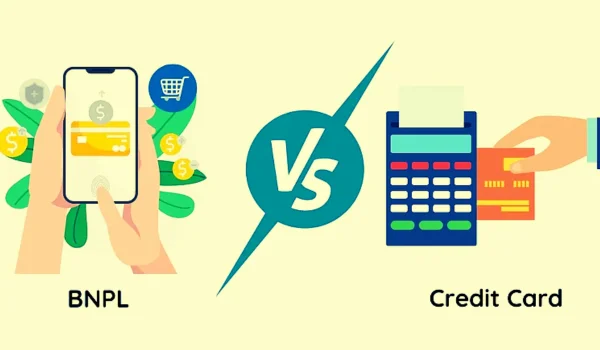The way Indians shop and borrow money has undergone a dramatic shift in recent years. While Credit Cards have been the traditional choice for instant credit, a new player—Buy Now, Pay Later (BNPL)—has quickly gained popularity, especially among millennials and Gen Z users.
As of 2025, both BNPL and credit cards offer the flexibility to buy now and pay later. However, they differ significantly in their structure, credit checks, rewards, interest rates, and long-term financial implications.
In this blog post, we’ll dive deep into the differences between BNPL and credit cards, compare their pros and cons, and help you decide which one is better suited for your lifestyle and financial goals in 2025.
💳 What is BNPL (Buy Now, Pay Later)?
BNPL is a short-term financing option that allows you to purchase products or services instantly and repay the amount later, either in a lump sum or through EMIs.
- Offered by fintech platforms like Simpl, LazyPay, ZestMoney, Amazon Pay Later, Paytm Postpaid, etc.
- Usually available directly at checkout on e-commerce sites and apps.
- Repayment period: ranges from 15 days to 12 months, depending on the provider.
- Some BNPL providers do not charge any interest for short-term payments (up to 15 or 30 days).
💳 What is a Credit Card?
A credit card is a revolving line of credit offered by banks and financial institutions. It allows users to spend now and pay the total amount within 30–50 days interest-free, or convert into EMIs.
- Offered by banks like HDFC, SBI, ICICI, Axis, Kotak, etc.
- Comes with credit limits, interest charges if payments are delayed, and annual or joining fees.
- Offers rewards, cashbacks, travel benefits, EMI options, and credit building.
🆚 BNPL vs Credit Cards: A Head-to-Head Comparison

| Feature | BNPL | Credit Cards |
|---|---|---|
| Eligibility | Minimal KYC, no CIBIL required | Requires CIBIL score (usually >700) |
| Credit Limit | Usually ₹10,000–₹1,00,000 | ₹20,000–₹10+ lakh based on income |
| Interest-Free Period | 15 to 30 days | 30–50 days |
| Interest Rates | 0% (short-term); 15–36% (EMIs) | 30–42% annually if not paid on time |
| EMI Option | Yes (on select BNPL providers) | Yes |
| Credit Score Impact | Growing impact (2025 onwards – RBI regulated) | Strongly impacts CIBIL score |
| Ease of Access | High – fast onboarding, no paperwork | Moderate – needs application and verification |
| Rewards/Cashback | Very limited | Extensive (miles, points, lounge access, cashback) |
| Annual Fee | None or negligible | ₹0 to ₹10,000+ depending on the card |
| Best For | Students, new earners, small-ticket purchases | Frequent shoppers, travelers, premium services |
🔍 Advantages of BNPL in 2025
✅ 1. No Credit Score Required (Initially)
BNPL providers offer loans to users without requiring a CIBIL score, making it ideal for students or first-time borrowers.
✅ 2. Instant Approval and Usage
BNPL is seamless and integrated with online platforms like Flipkart, Amazon, Myntra, Swiggy, and Zomato. Signup takes less than 5 minutes.
✅ 3. No Hidden Fees (for short-term)
Short-term BNPL options (like 15–30 days) often come with zero interest, if repaid on time.
✅ 4. Flexible Repayment
EMI-based BNPL services allow you to split larger purchases over 3–12 months.
🔍 Advantages of Credit Cards in 2025
✅ 1. Better Rewards and Offers
Credit cards offer air miles, cashback, hotel bookings, movie ticket discounts, dining offers, and more.
✅ 2. Builds Credit Profile
Responsible usage of a credit card helps build a CIBIL score, enabling access to loans, home finance, and car loans in the future.
✅ 3. Higher Spending Power
Credit cards offer higher limits than BNPL, giving more flexibility for travel, medical expenses, and emergency needs.
✅ 4. EMI Conversion at Low Cost
Most credit cards allow you to convert large purchases into EMIs at lower interest or zero-cost.
📉 Disadvantages of BNPL
- Can lead to overspending, especially for impulsive buyers.
- Late payments may now be reported to credit bureaus under new RBI guidelines.
- Limited acceptance – only works with partner merchants.
- Not suitable for large purchases or travel needs.
📉 Disadvantages of Cre@dit Cards
- High interest charges (30–42%) if you miss payments.
- Annual and late payment fees may apply.
- Harder to qualify if you have low income or poor credit score.
- Risk of falling into a debt trap if not managed well.
📊 BNPL vs Credit Card in 2025: Best Use Cases
| Use Case | Recommended Option | Why? |
|---|---|---|
| College students shopping | BNPL | No credit score needed, easy to repay in 15 days |
| Daily purchases on Swiggy | BNPL | Instant approval, no interest |
| International travel booking | Credit Card | Rewards, high limit, emergency coverage |
| Building credit history | Credit Card | Helps improve CIBIL score |
| EMI for electronics purchase | Both (based on rates) | Compare BNPL and credit card EMI offers |
💡 What’s New in 2025?
Thanks to RBI’s 2024 BNPL guidelines, BNPL providers are now required to:
- Report repayment behaviour to credit bureaus.
- Follow responsible lending norms.
- Disclose all charges clearly before checkout.
This makes BNPL more regulated and safer, but also more similar to credit card lending.
🧠 Final Verdict: Which One Should You Choose?
There’s no one-size-fits-all answer—it depends on your lifestyle and financial habits.
✅ Choose BNPL If:
- You’re new to credit
- You need short-term help for small purchases
- You want quick, interest-free repayment
✅ Choose Credit Card If:
- You want to build credit score
- You’re a frequent online or offline spender
- You can manage bills responsibly to earn rewards
Many Indians in 2025 use both—BNPL for day-to-day purchases and credit cards for big-ticket items and credit history building.
🧾 Pro Tip: Use Both Smartly
Combine both BNPL and credit cards by:
- Using BNPL for under ₹5,000 expenses on Zomato or Flipkart.
- Using credit cards for travel, EMI conversions, and fuel benefits.
- Always paying your dues on time to avoid interest or credit damage.

